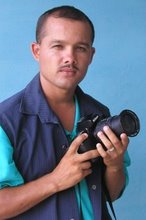By Isabel García Granado.
Isabel García Granado’s interview with Amauris Betancourt, Radio Angulo Digital's photoreporter, in Café Millenio, a cultural program from the CMKO Angulo Radio Broadcasting Station, the author of the photographic exposition “ Holguín: 50 Years of Revolution”, inaugurated recently.
Isabel García Granados (IGG): Thanks for coming to our program and many congratulations for Christmas Eve and for the exhibit.
Amauris Betancourt Gómez (ABG): Thanks Isabel for the invitation and my greetings to listeners, to you and to Néstor.
IGG: 50 photos gathered 50 important moments from the daily life of present-day Cubans. I read the writer Manuel García Verdecia’s praising words for the catalogue about your work, but I would like to know about the curatorship process, specifically of that many images that a photographer always has when picking up given photos for an exhibition.
ABG: First of all I want to express my thankfulness to Professor Manuel García Verdecia, my professor at the university, because of the words for that catalogue and also to Fabio Ochoa for helping me choose the photographs.
I went through the archives of four years of work and I selected initially 243 photos. Next I turned to journalist and designer Fabio Ochoa for a reduced selection. Although usually I devote myself to editing photos, to edit for others is much easier. Self-editing proves to be quite difficult. We picked up firstly 92, then 60, to finally get, with the photographer Juan Miguel Cruz's help, the 50 ones already on exhibit.
IGG: It all has a thematic diversity that I guess it must be related to your work as a photojournalist?
ABG: It is. The photo, in photojournalism as well as in the art field, if it is loved, always receives that creative component although objectivity in journalism renders quite important in favor of subjectivity in art photography.
However, when it comes to getting across a message we turn to a given composition to be able to achieve proper communication. To a certain extent, many of the pictures are closely related to photojournalism in a journey through the achievements in the present-day Cuban society, in 50 years of the January Revolution: education, sports, nickel – so important for the country’s economy, and the rallies that have joined Cubans are not missing; and culture, of course, which I go in for and what is so important for the Island.
There are also images related with Angulo Radio Broadcasting Station where I currently work. As to the theme of culture, I have portraits of personalities that are as such institutions, part of our history, not only in Holguín but in Cuba. The Nicolas de la Peña’s portrait I like very much for instance. Nicolás is linked not only to Holguín’s history but to the one belonging to Cuba because he broke the news that Fidel was still alive in Alegría de Pío when newspapers said he had died.
IGG: Besides he is a man that dedicated a long time to radiojornalism at this own broadcasting station. Amauris, you talked about objectivity and subjectivity ¿how do you manage to bring them into line as a photographer?
ABG: Objectivity is very important in the photojournalist message you must convey to readers. I look, in my photo work basically for Internet in a digital edition for the whole world, for something picturing and identifying Cuba. I make use continuously of the Cuban flag or some other element of idiosyncrasy: music, dance, joy, coquetry. And subjectivity is that aspect that can be read above and beyond what the photo really depicts. Roland Barthes, a French semiotitian, refers to this duality relationship in photography: the denoted and connoted message. I bear this in mind besides the influence of Cartier Bresson, forerunner of contemporary photojournalism. And I include my cultural interests because I majored in a university specialty related with letters..
IGG: What did you major in?
ABG: English philology. I wanted to learn English. Learning a language means drinking from that culture that backs it up.
IGG: And when doing photoreports sometimes you do works out of assignments, but there is always a personal pleasure for given topics. In your case, which would they be?
ABG: I am interested in cultural topics and social photography because I have social worries. I try reflecting many things that worry us as human beings; I try to honor musicians, cultural leaders, the ones we see in a film or on TV, writers, the ones we look up to as examples to our existence, the ones we admire as public personalities.
This career has given me the opportunity to know face to face the ones I read, listened to or saw on TV and movies.
I try to come out with messages related to social issues and to get close to the human being behind public faces.
IGG: You have a list of acknowledgement: Designer Adrián López, Cary Sayas, Jormit, the Cuban Social Communication Association (ACCS), to Angulo Radio Broadcasting Station.
ABG: The original idea belongs to Jaime Batista (the ACCS's president) and I thank too Angulo Radio Broadcasting Station, in the person of our director Moraima López, who in a casual and fortunate lunch made the exhibit come true. Fabio helped me a lot; Adrián, with the poster; and, of course , Jormit can not be left out. He did the montage of the exposition. If I have the gratitude of the ones that approached and congratulated me I owe it to Jormit also.
IGG: Thanks to Amauris then, the photographer of the 50 images about today’s Cuba, whom likes digging into cultural topics and getting close to the yeast behind faces that make up the Cuban society. Thank you very much Amauris.


No hay comentarios.:
Publicar un comentario